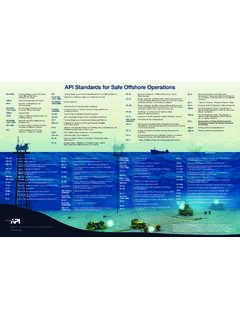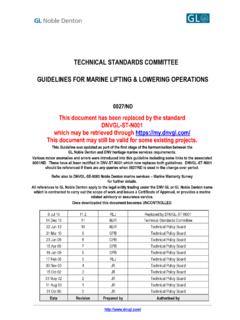Transcription of OFFSHORE PERSONNEL TRANSFER BY CRANE - Reflex Marine
1 REV 0 MAY 20161 REV 0 MAY 2016 BEST PRACTICE guidelines FOR ROUTINE AND EMERGENCY OPERATIONSOFFSHORE PERSONNEL TRANSFER BY CRANEREV 0 MAY 2016 CONTENTS1 >INTRODUCTION Purpose of this document 02 Global perspective 03 Definition of a CRANE TRANSFER system 04 Applications of CRANE TRANSFER 06 2 >RISK MANAGEMENT 07 Risk awareness 08 Risk factors 10 Risk assessment 143 >OPERATIONAL BEST PRACTICE 15 General 16 TRANSFER procedures 18 Emergency operations 214 >RESOURCES 24 5 >REFERENCES 25 6 >APPENDICES 24 A Risk assessment template 26 B Pre- TRANSFER checklist template 28 C Passenger log template 29 D Post- TRANSFER review template 30 PAGESECTIONREV 0 MAY 2016 SECTION 1 0 MAY 201602 SECTION 1 >INTRODUCTIONSECTION 1 > PURPOSE OF THIS DOCUMENT This document provides best practice guidance to help ensure that PERSONNEL transfers by CRANE are conducted safely, whether for routine crew changes or operational reasons.
2 It also highlights the critical role that CRANE TRANSFER can play in the management of emergencies, and the importance of preparation for such eventualities. It is of particular relevance to oil & gas exploration and production, OFFSHORE renewables construction and maintenance, as well as general Marine operations. It is intended for those planning, managing and performing such operations. Drawing on recent industry risk studies on OFFSHORE PERSONNEL TRANSFER , it provides a broad operational context to assist risk-based decision making and objective assessment of the various TRANSFER methods available. This guidance is based on worldwide experience and followed a thorough industry consultation. This guidance document has been produced by the Marine TRANSFER Forum which aims to: > Encourage the collation and sharing of activity and incident data to increase awareness, benchmark activity and quantify risks > Share and develop industry best practice for both routine TRANSFER operations and emergency planning > Support the development of clearer objectives and strategies to improve equipment, services and industry practices.
3 More information on the Marine TRANSFER Forum and how you can join can be found at REV 0 MAY 201603 SECTION 1 >INTRODUCTION7 8M TRANSFERS PER YEARCREW TRANSFERS PER A GLOBAL PERSPECTIVE Every year around nine million passenger transfers to OFFSHORE installations are made by helicopter, and an estimated seven million passenger transfers are conducted by sea. Marine based crew supply encompasses a range of different methodologies including CRANE TRANSFER , walk to work, step-over (to a ladder or boat landing) and swing rope. Of these, CRANE TRANSFER is the most common method, accounting for around five million2 passenger transfers per annum. CRANE TRANSFER practices vary considerably from region to region. In some areas of the world, these practices have changed little in the past fifty years. In other areas, such as Atlantic Canada, operators have collaborated and redefined industry best practice and have gained an impressive track record for safe operations in some of the most challenging environmental conditions globally.
4 CRANE TRANSFER has evolved significantly in recent years; carrier design, CRANE design, vessel design and operational practices have all improved greatly to allow crews to travel with increased safety and comfort. Safe CRANE transfers rely on collaboration across several disciplines; including lifting, Marine logistics, health and safety, and asset TRANSFERS PER YEAR9M PASSENGER TRANSFERS BY HELICOPTER7M PASSENGER TRANSFERS BY SEA= CRANE TRANSFERS= OTHER Marine TRANSFERS1, 2 See references in Section 5 REV 0 MAY 201604 SECTION 1 >INTRODUCTIONA pplicable legislation, standards and codesThere are a range of statutory requirements, industry codes, standards and guidelines which may be applied to CRANE TRANSFER operations. Some of these codes are quite specific on the design of equipment, such as cranes and PERSONNEL carriers, and others provide more general advice on best practice.
5 Not all such guidance, however, reflects recent changes in the industry or represents current international best installation Cranes used for TRANSFER of PERSONNEL may be positioned either on fixed or floating structures such as platform, jack-up, semi-submersible, FPSO, or barge. On floating structures and vessels the stability in varying sea conditions affects the movement of the CRANE boom tip, strongly impacting the dynamics of the lift. The lifting path, line of sight to the vessel and installation landing areas may vary greatly from site to A CRANE suitable for PERSONNEL TRANSFER should be certified for lifting people. Other relevant risk factors are the CRANE location relative to vessel landing areas and the prevalent weather, the CRANE operator view, lifting path, line speed, and rigging. VesselA wide range of vessels are employed in PERSONNEL TRANSFER , from large, specialised OFFSHORE support vessels to small crew TRANSFER vessels.
6 Vessels with suitable cranes can TRANSFER PERSONNEL to other vessels or structures. In all cases, vessel stability, station-keeping, deck landing area and visibility from bridge should all be accounted for in assessing the suitability for each vessel and the operational carrier Only devices designed specifically for the purpose of transferring PERSONNEL between vessels and OFFSHORE installations should be used. These may be collapsible standing baskets , rigid-standing or rigid-seated devices. Work baskets should not be used for the TRANSFER of PERSONNEL between vessels and installations. PersonnelThe safe conduct of CRANE TRANSFER operations requires the close collaboration of several different parties. Because it is conducted between a vessel and an installation two different organisations and work cultures are involved. Each party has specific responsibilities, pressures, and considerations to deal with; thus managing the risks effectively requires the close collaboration in both the planning, preparation and conduct of operations.
7 The person in overall charge is normally appointed by the asset manager or vessel master and must ensure that the PERSONNEL involved have the relevant competence to conduct operations safely. DEFINITION OF A CRANE TRANSFER SYSTEM In order to address the risks and define best practice for CRANE TRANSFER operations, it is necessary to consider all elements in the system. Each part of the system should be evaluated on its own merit, and finally the interactions of the various elements of the whole system should also be 0 MAY 201605 SECTION 1 >INTRODUCTION >DEFINITION OF A CRANE TRANSFER SYSTEM > PERSONNELC ompetence often has a specific meaning, and the term competent person can have a specific definition. Where used in this document it signifies that persons have sufficient practical and theoretical knowledge and experience of the lifting equipment to perform their duties safely.
8 The duty holder is a statutory term in health and safety legislation and can be a company or an individual. They are responsible for things being done correctly, or put right. In the oil and gas industry, it is the operator of a fixed installation, and the owner of a mobile roles involved in CRANE TRANSFER operations include:> Onshore management Onshore operations managers (often supported by safety advisors) are usually responsible for evaluating risks and defining the TRANSFER methodology to be used, and making the appropriate provisions of equipment and processes.> Logistics Onshore and OFFSHORE logistics staff co-ordinate passenger bookings, briefings, luggage, security, and the issue of appropriate personal protective equipment (PPE).> OFFSHORE management The manager for the installation or vessel where the CRANE is located, is normally in overall control of individual TRANSFER operations, and conducts local onsite risk assessments with the support of the CRANE operator and vessel master prior to any TRANSFER .
9 The manager should also consider, and if needed risk assess, other installation activities (SIMOPS) that could affect CRANE TRANSFER activities.> Vessel crew The vessel master and crew are responsible for the safety of passengers during the voyage to and from the installation, and for operations on the vessel deck. The vessel master has a specific responsibility to maintain the vessel on station during the TRANSFER operations and to check the safety of the designated landing area. Passenger briefings may also take place on the vessel during transit.> CRANE operator The CRANE operator is responsible for operating the CRANE , which is also supported by a lifting supervisor and deck crews on both the vessel and the installation. The CRANE operator along with the CRANE mechanic are responsible for ensuring the CRANE is in a safe condition to perform PERSONNEL transfers, and coordinating operations with installation deck crews and the vessel information on training andcompetence is found in Section ( PERSONNEL ).
10 REV 0 MAY 201606 SECTION 1 >INTRODUCTIONR outine crew changeMarine based crew TRANSFER is a standard operation in most regions of the world. Primary reasons for selecting Marine TRANSFER over other methods include:> Volume: dedicated crew TRANSFER vessels can transport large numbers of passengers> Economy: Marine TRANSFER is a flexible and cost-effective method that can be tied-in with cargo operations> Safety: Marine TRANSFER is safer than using helicopters, the main global alternative method> Infrastructure: Marine based transfers are generally easier to establish and support, particularly in remote areas> Distances from shore: many OFFSHORE assets are relatively close to shore, so voyage times are relatively short. However, in some locations, Marine TRANSFER is selected because assets are a long way OFFSHORE and beyond helicopter operating range. ContingencyWhere methods such as helicopter or walk to work are the primary means, CRANE TRANSFER provides an important secondary means of access.









